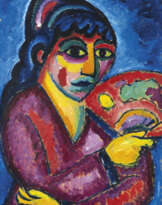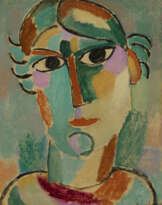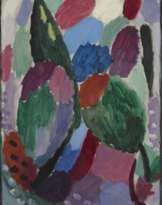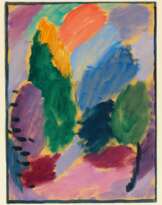ID 847258
Lot 35 | Alexej von Jawlensky (1867 Moskau - 1941 Wiesbaden)
Estimate value
€ 35 000
'Meditation', Öl auf leinenstrukturiertem Papier auf Karton montiert, 17,5 cm x 12,5 cm, Unterlagekarton 30,5 cm x 25 cm, monogrammiert, 36 datiert, verso auf dem Unterlagekarton A. Jawlensky bezeichnet, IX. 1936 datiert, N. 20 nummeriert, I.A bezeichnet, in den Ecken Stecknadellöcher, Kante unten rechts mit minimalem Papierabriss (durch das Stecknadelloch), Unterlagekarton mit Montierungsrückständen. Das Gemälde wurde im Oktober 2022 dem Alexej von Jawlensky-Archiv S.A. vorgelegt, Bestätigung der Aufnahme in das Werkverzeichnis folgt.
Der deutsch-russische Maler Alexej von Jawlensky absolvierte zunächst die Militärakademie in Moskau und studierte anschließend an der St. Petersburger Kunstakademie und mit Künstlerkollegen, wie Wassily Kandinsky, in München. Er war Gründungsmitglied der Neuen Künstlervereinigung München und stand somit der weltbekannten Künstlergruppe "Blauer Reiter" nahe. Seine Farbpalette besteht aus leuchtenden Farben und markantem Pinselduktus mit dunklen Umrisslinien, die stets dem figurativen verhaftet blieben. Doch bewegte er sich mit den Jahren durch seine Arbeiten zu den Zügen des menschlichen Gesichts hin zur Abstraktion. Zur Werkreihe "Meditation" gehört unser vorliegendes Werk von 1936 ebenso, wie jenes Gesicht auf Goldgrund im Museum Lenbachhaus München. Seit 1929 litt Alexej Jawlensky an Arthritis, die ihn während seiner letzten Werkphasen in eine fast vollständige Lähmung zwang, die Malerei ganz aufzugeben. "So gingen die Jahre in großer Arbeit. Und dann wurde ich krank und konnte wohl weiter arbeiten, trotzdem meine Hände immer mehr und mehr steif wurden. Ich konnte den Pinsel nicht mehr in einer Hand halten, musste beide Hände dazu nehmen, immer mit großen Schmerzen. Mein Format wurde ganz klein, auch musste ich eine neue Technik finden. Drei Jahre malte ich diese kleinen abstrakten Köpfe wie ein Besessener. Da fühlte ich, dass ich bald ganz aufhören musste zu arbeiten. Und so kam es auch!" Der Kunsthistoriker Armin Zweite hat sich mit den drei Arbeitsjahren des Künstlers zwischen 1934 - 1937 beschäftigt und die Variationen von über Hunderten von Arbeiten des Künstlers analysiert. Das Kopfmotiv zeigt "[.] schwere Balken in tiefem Schwarz das griechische Kreuz, das auf der waagrechten Markierung des Mundes ruht und oben durch die stirnbegrenzenden Brauen überfangen wird. Aufgrund der parallelen Pinselspuren gewinnen die dazwischen liegenden Flächen eine eigene Struktur. [.] An der Nasenwurzel leuchtet das zum Abschluss aufgetragene Weisheitszeichen in hellem Ton und unterstreicht den religiös-meditativen Charakter der Bilder zusätzlich." Dieser Charakter wirkt auch in unserem Werk wie der einer Ikone. Das malerische Antlitz wird hier in blau, rot, grün und gelblichen Tönen in Farbfelder aufgeteilt und wirkt trotz der starken Abstraktion äußert emotional und tiefgründig. Selbst wenn dieses betrübt gefasste Gesicht nicht auf Goldgrund gesetzt wurde, ist es doch von starker Spiritualität durchzogen. Literatur: Friedel, Helmut; Hoberg, Annegret: Der Blaue Reiter im Lenbachhaus München, Prestel Verlag, 2007
Alexei von Jawlensky (1867 Moscow - 1941 Wiesbaden)'Meditation', oil on linen-textured
paper mounted on cardboard, 17.5 cm x 12.5 cm, backing board (dimensions) 30.5 cm x 25 cm, monogrammed, dated 36, inscribed on verso of backing board A. Jawlensky, dated IX. 1936, numbered N. 20, inscribed I.A, pinholes in corners, edge lower right with minimal paper tear (through pinhole), backing board with mounting residues. The painting was submitted to the Alexej von Jawlensky Archive S.A. in October 2022, confirmation of inclusion in the catalogue raisonné follows.
The German-Russian painter Alexej von Jawlensky first graduated from the military academy in Moscow and then studied at the St. Petersburg Art Academy and with fellow artists, such as Wassily Kandinsky, in Munich. He was a founding member of the Neue Künstlervereinigung München and was thus close to the world-famous ''Blauer Reiter'' group of artists. His colour palette consists of bright colours and a striking brushstroke with dark outlines that always remained figurative. However, over the years he moved towards abstraction through his works on the features of the human face. Our present work from 1936 belongs to the ''Meditation'' series, as does the face on a gold background in the Lenbachhaus Museum in Munich. Since 1929, Alexei Jawlensky had suffered from arthritis, which forced him into almost complete paralysis during his last phases of work, forcing him to give up painting altogether. ''So the years went by in great work. And then I fell ill and I suppose I could go on working, even so my hands became more and more stiff. I could no longer hold the brush in one hand, I had to use both hands, always with great pain. My format became very small, and I also had to find a new technique. For three years I painted these little abstract heads like a man possessed. Then I felt that soon I would have to stop working altogether. And so it came to pass!'' Art historian Armin Zweite has studied the artist's three working years between 1934 - 1937 and analysed the variations of over hundreds of the artist's works. The head motif shows ''[...] heavy bars in deep black the Greek cross resting on the horizontal marking of the mouth and overlaid above by the brows bordering the forehead. Due to the parallel brushstrokes, the intervening areas gain a structure of their own. [.] At the root of the nose, the wisdom sign applied at the end shines in a light tone and further underlines the religious-meditative character of the paintings.'' This character also appears in our work like that of an icon. Here, the painterly countenance is divided into colour fields in blue, red, green and yellowish tones and, despite the strong abstraction, appears extremely emotional and profound. Even if this sorrowful face was not set on a gold ground, it is still permeated by a strong spirituality. Literature: Friedel, Helmut; Hoberg, Annegret: Der Blaue Reiter im Lenbachhaus Munich, Prestel Verlag, 2007
| Artist: | Alexej von Jawlensky (1864 - 1941) |
|---|---|
| Auction house category: | Paintings and mixed media |
| Artist: | Alexej von Jawlensky (1864 - 1941) |
|---|---|
| Auction house category: | Paintings and mixed media |
| Address of auction |
WETTMANN | Auktionshaus an der Ruhr Friedrichstraße 67-67a 45468 Mülheim an der Ruhr Germany | ||||||||||||||
|---|---|---|---|---|---|---|---|---|---|---|---|---|---|---|---|
| Preview |
| ||||||||||||||
| Phone | +49 (0)208 3059081 | ||||||||||||||
| Fax | +49 (0)208 4391735 | ||||||||||||||
| Buyer Premium | 30% | ||||||||||||||
| Conditions of purchase | Conditions of purchase | ||||||||||||||
| Business hours | Business hours
|

















